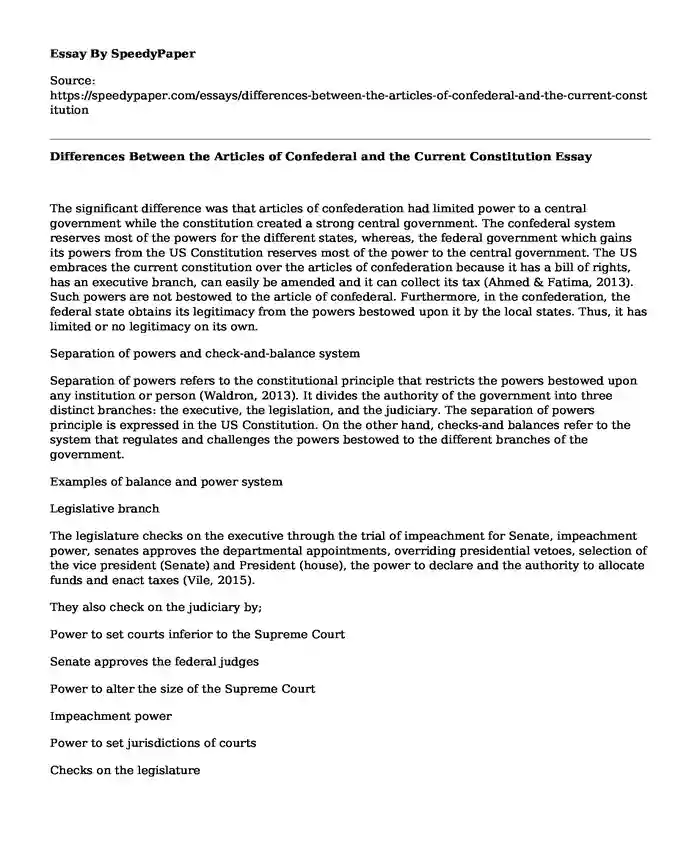
| Type of paper: | Essay |
| Categories: | United States Government Constitution |
| Pages: | 2 |
| Wordcount: | 436 words |
The significant difference was that articles of confederation had limited power to a central government while the constitution created a strong central government. The confederal system reserves most of the powers for the different states, whereas, the federal government which gains its powers from the US Constitution reserves most of the power to the central government. The US embraces the current constitution over the articles of confederation because it has a bill of rights, has an executive branch, can easily be amended and it can collect its tax (Ahmed & Fatima, 2013). Such powers are not bestowed to the article of confederal. Furthermore, in the confederation, the federal state obtains its legitimacy from the powers bestowed upon it by the local states. Thus, it has limited or no legitimacy on its own.
Separation of powers and check-and-balance system
Separation of powers refers to the constitutional principle that restricts the powers bestowed upon any institution or person (Waldron, 2013). It divides the authority of the government into three distinct branches: the executive, the legislation, and the judiciary. The separation of powers principle is expressed in the US Constitution. On the other hand, checks-and balances refer to the system that regulates and challenges the powers bestowed to the different branches of the government.
Examples of balance and power system
Legislative branch
The legislature checks on the executive through the trial of impeachment for Senate, impeachment power, senates approves the departmental appointments, overriding presidential vetoes, selection of the vice president (Senate) and President (house), the power to declare and the authority to allocate funds and enact taxes (Vile, 2015).
They also check on the judiciary by;
Power to set courts inferior to the Supreme Court
Senate approves the federal judges
Power to alter the size of the Supreme Court
Impeachment power
Power to set jurisdictions of courts
Checks on the legislature
Bills must be passed by both houses
Neither house can adjourn for three or more days without the approval of the other house
Judicial branch
Checks on the Executive
The chief justice acts as the president of the Senate when the president is being impeached
Judicial review
Checks on the legislature
Compensation cannot be diminished
Judicial review
Seats are held on good behavior
References
Ahmed, M., & Fatima, Z. (2013). Separation of Power: Analysis of Theory and Practice. The Government-Annual Research Journal of Political Science., 2(02).
Vile, J. R. (2015). The Nation and the States: The Arrangement Is Federal, Not Confederal or Unitary. In The United States Constitution (pp. 87-98). Palgrave Macmillan US.
Waldron, J. (2013). Separation of Powers in Thought and Practice. BCL Rev., 54, 433.
Cite used http://www.shmoop.com/constitution/checks-and-balances.html
Cite this page
Differences Between the Articles of Confederal and the Current Constitution. (2019, Oct 28). Retrieved from https://speedypaper.net/essays/differences-between-the-articles-of-confederal-and-the-current-constitution
Request Removal
If you are the original author of this essay and no longer wish to have it published on the SpeedyPaper website, please click below to request its removal:
- Free Essay on Public Internet Implementation
- Customer Is Always Right Essay Examples
- Case Study Based On Gibb's Reflective Model. Free Essay.
- Laws of Demand and Supply - Free Essay in Economics
- Management Essay Example: Organizational Framework
- Free Essay on Marketing Concept and Social Responsibilities
- Essay Sample about Barack Obama: A Contextualization
Popular categories




